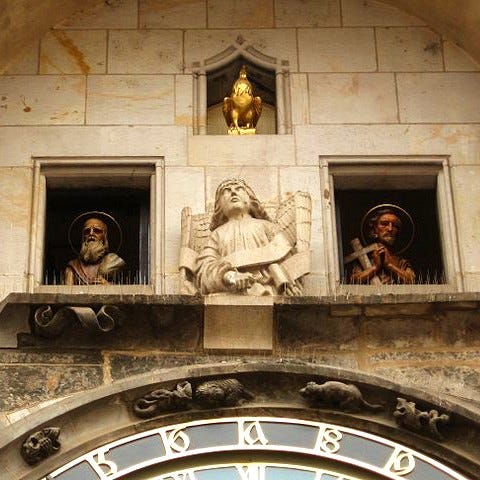Bells, rattles, and chimes have been entertaining humans with their tinkling, ringing, and clanking sounds for millennia.
I’m sure some prehistoric man one day shook a dry gourd with the seeds still in it and was fascinated by the scratching of pips against the hollow shell.
Hey, that’s an interesting sound!
Then maybe the same guy banged his walking stick against a hollow rock and discovered that a resonant sound came from the clash of wood on rock. Intrigued, he tried hitting various types of thin rocks or wood pieces and understood that each thickness and distinct material made different pleasant sounds.
And voilá, instrumental music was born!
Invention of Bronze Bells
The Chinese probably developed metal gongs, rattles, and various types of bells in the Bronze Age (~3000 BC), which then blossomed into a whole science of sound progressing in sophistication with each generation.
Recently, I came across the most amazing picture of a huge Chinese musical instrument called a Bianzhong, dating to 433 BC. It consists of 64 hand-crafted bells played by five musicians at once. This is a single instrument! Check it out:

It looks kind of menacing, doesn’t it? Can you even imagine what that would have sounded like?
(I’m told the Chinese government just last year settled all the lawsuits from people claiming PTSD from sitting through Bianzhong concerts.)
Some time soon I’ll do a Newsletter on the development of church bells in particular, but for the purpose of this Vignette, I only wish to note that bells and clanging instruments of various types have always traveled with technological innovations through time.
The sounds don’t really change (because they’re just vibrations of air), but the musical concepts and their machines do. Here’s one quick example from a previous SW article.
The Astronomical Clocks
If you were a resident of Prague in the 1400s you would have been entertained by the glockenspiel display in the clocktower at the center of town. Actually, you can see this same set-up today if you go there.
The machine is called the Orloj (translated: the Clock!) and not only displays the time of day but also the zodiac signs and various constellations; a map of the heavens; the phases of the sun and moon, and a 12-month Church calendar. They all rotate in harmony with each other.
The best part of the clock is its moving display of sculpted Apostles that pop out of windows above it and present to the viewers a kind of medieval morality play.
Another figure holds a hammer and looks to be striking the bells that ring on the hour. (The bells are hidden behind the clock.)


The Prague Orloj is one of many such clocks in Europe, but all kinds of their kith and kin— grandfather clocks, music boxes, player pianos, pipe organs, etc.—operate on the same principle: they blend technology and musical instruments.
A Modern Musical Phenomenon
Nothing beats the modern musical contraption called the Wintergatan Marble Machine, however. It was created in 2016 by its talented Swedish inventor, Martin Molin, who put sixteen months into building it.
Just seeing it in operation (in the video below) will be enough to illustrate the wonder of this phenomenon, but I’d like to point out a few items of interest first:
Molin designed and crafted every piece of this complex machine by hand (it’s mostly plywood), minus the electronic instruments, which he programmed to amplify the sounds of the marbles striking hard surfaces.
It operates by way of that good old-fashioned method of locomotion: a hand crank. Once going, it can coast on momentum for a while, yet when the cranking stops, the machine grinds to a halt.
2000 steel marbles course through tracks in the machine that look strangely like a turnpike toll gate at rush hour in a big city.
The marbles flow like water through the machine and recycle themselves for further musical action.
As they run their gauntlets, the marbles make percussive sounds on a drum, a bass, a cymbal, and the keys of a vibraphone to generate the machine’s unique sound. You’ll even see what looks like a guitar on the front console, which Molin plucks and strums to complement the other sounds.
One writer said it has a “Frankenstein appearance,” (yeah, it kind of does) but what I like most about this performance is the artist’s engagement with his own creation.
A Sacred Window of Creativity
The human creative element is what makes it a musical instrument, rather than a freakish looking bucket of bolts, gears, and levers. The musician makes it sing.
For that reason, I do not think Molin has lost his marbles. In fact, I think he’s a real creative genius who has given us a kind of window into divine creativity.
The complexity of this machine is no competition to the One who created the Human Genome, but it reminds us of Him.
More to the point: God too remains engaged in His own creative work, and if He ever stopped filling the universe with His life, our whole world would come to a screeching halt.
As I said, the musical notes and sounds don’t change through the centuries, but the technology develops from one machine to another. This marvelous marble music machine is a distant outcropping of some earlier technologies, which is why it sort of…um…rings a bell.






So amusing that I'd see this post today -- just yesterday while working in my studio I tuned into an ambiance channel that played wind chimes for 10 hrs. (While repetitive, it was honestly the most soothing ambiance music I've found to work to!)
That clock in Prague is something else!! I did a painting of it once; as I was making study notes and sketches for the final work I learned it's only stopped running once I think in 600 years??? Incredible.